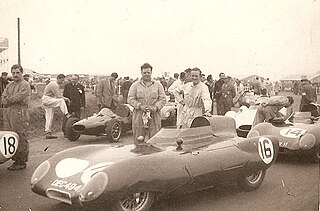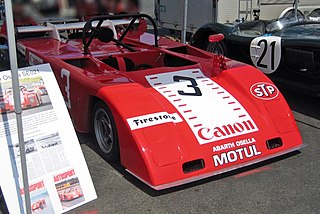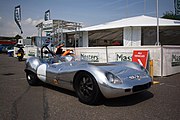
The Ford GT40 is a high-performance endurance racing car designed and built by the Ford Motor Company. It grew out of the "Ford GT" project, an effort to compete in European long-distance sports car races, against Ferrari, who had won the prestigious 24 Hours of Le Mans race from 1960 to 1965. Ford succeeded with the GT40, winning the 1966 through 1969 races.

Lotus Group is a British multinational automotive manufacturer of luxury sports cars and electric lifestyle vehicles.

The AC Cobra, sold in the United States as the Shelby Cobra and AC Shelby Cobra, is a sports car manufactured by British company AC Cars, with a Ford V8 engine. It was produced intermittently in both the United Kingdom and later the United States since 1962.
Lola Cars International Ltd. was a British race car engineering company in operation from 1958 to 2012. The company was founded by Eric Broadley in Bromley, England, before moving to new premises in Slough, Buckinghamshire and finally Huntingdon, Cambridgeshire, and endured for more than fifty years to become one of the oldest and largest manufacturers of racing cars in the world. Lola Cars started by building small front-engined sports cars, and branched out into Formula Junior cars before diversifying into a wider range of sporting vehicles.

Coventry Climax was a British forklift truck, fire pump, racing, and other speciality engine manufacturer.

The Ferrari250 Testa Rossa, or 250 TR, is a racing sports car built by Ferrari from 1957 to 1961. It was introduced at the end of the 1957 racing season in response to rule changes that enforced a maximum engine displacement of 3 litres for the 24 Hours of Le Mans and World Sports Car Championship races. The 250 TR was closely related to earlier Ferrari sports cars, sharing many key components with other 250 models and the 500 TR.

Elva was a sports and racing car manufacturing company based in Bexhill, then Hastings and Rye, East Sussex, United Kingdom. The company was founded in 1955 by Frank G. Nichols. The name comes from the French phrase elle va.
Hewland is a British engineering company, founded in 1957 by Mike Hewland, which specialises in racing-car gearboxes. Hewland currently employ 130 people at their Maidenhead facility and have diversified into a variety of markets being particularly successful in electric vehicle transmission supply.

A Daytona Prototype was a type of sports prototype racing car developed specifically for the Grand American Road Racing Association's Rolex Sports Car Series as their top class of car, which replaced their main prototype racing class, specifically Le Mans Prototypes (LMPs). The cars later competed in the merged series of the IMSA SportsCar Championship, from 2014 to 2016, before being phased out and replaced by the Daytona Prototype International class in 2017. They are named after the main series event, the Rolex 24 at Daytona.
Eric Harrison Broadley MBE was a British entrepreneur, engineer, and founder and chief designer of Lola Cars, the motor racing manufacturer and engineering company. He was arguably one of the most influential automobile designers of the post-war period, and over the years Lola was involved with many high-profile projects in Formula One, IndyCar, and sports car racing. Broadley sold Lola to Martin Birrane in 1997.

The Eagle Mk1, commonly referred to as the Eagle T1G, was a Formula One racing car, designed by Len Terry for Dan Gurney's Anglo American Racers team. The Eagle, introduced for the start of the 1966 Formula One season, is often regarded as being one of the most beautiful Grand Prix cars ever raced at the top levels of international motorsport. Initially appearing with a 2.7L Coventry Climax inline 4-cylinder engine, the car was designed around a 3.0L Gurney-Weslake V12 which was introduced after its first four races. In the hands of team boss Gurney, the Eagle-Weslake won the 1967 Belgian Grand Prix, making Dan Gurney only the second driver at the time, and one of only three to date, to win a Formula One Grand Prix in a car of their own construction. Excluding the Indianapolis 500, that win in Belgium still stands as the only win for a USA-built car as well as one of only two wins of an American-licensed constructor in Formula One. It was also the first win for an American constructor in a Grand Prix race since the Jimmy Murphy's triumph with Duesenberg at the 1921 French Grand Prix.
Jeffery Macandrew-Uren, was a British engineer, racing driver, race team manager, tuner, customiser, and entrepreneur. He won the British Saloon Car Championship in its sophomore year. He was a driver and team manager for Ford Motor Company's rallying efforts, team manager with John Willment's racing division, and team manager for AC Cars' 1964 Le Mans team. He later created a series of performance-oriented engine-swapped custom Ford models.

John Crosthwaite was an English race car designer and engineer, active in both the United Kingdom and the United States.

The Lola Mk6 GT was a racing car with a production run of only three units, built between 1962 and 1963 by British car manufacturer Lola Cars. With its 289 cu in (4.74 L) Ford V8 engine, the Mk6 GT was the first mid-mounted, high displacement V8-powered Grand Touring car, a chassis arrangement that had been used, up until that time, only on formula cars and smaller, more affordable GTs.

William George Sadler designed, built, and drove his own sports racing cars, some of which anticipated the later Formula 5000 and Can-Am cars. He left racing and earned a Masters of Electrical and Electronics Engineering, then went on to design and build light aircraft and aircraft engines, and was involved in the early development of Unmanned aerial vehicles (UAVs).
The Lola T160, and its evolution, the Lola T165, is a series of purpose-built Group 7 sports prototype race cars, designed and developed by British chassis manufacturer Lola Cars, specifically to compete in the Can-Am series in 1968. It was the successor to the competitive T70, sharing similar design knowledge and cues. Lola built the chassis, constructed out of fiberglass, and molded into an aluminum monocoque. This meant the car was light was lightweight, weighing only 670 kg (1,480 lb). The chassis was designed to accept a small-block engine, but most cars were powered by either the Chevrolet ZL1 or the Ford FE "big-block" motors, generating about 625–750 hp (466–559 kW); mated to a 4-speed or 5-speed Hewland L.G.500 or L.G.600 manual transmission. This made the cars very fast, with a notably excellent power-to-weight ratio. It was used in active competition until 1971, and was succeeded and used alongside the new T220 in 1970.

The Abarth-Osella 2000 Sport SE-021 is a mid-engined, Group 5, prototype race car, built by Osella to compete in the World Sportscar Championship sports car racing series in 1972, and for some races in 1973. The chassis itself was developed and developed by Osella, while the car itself was powered by a 2.0 L (120 cu in) Abarth four-cylinder engine, generating a healthy 265 hp (198 kW). Since the light and nimble chassis only weighed 530 kg (1,170 lb), this gave it an incredible power-to-weight ratio. It was entered 39 times in races, and had 10 podiums. It scored 8 wins in its career.

The Osella PA3 is a Group 6 prototype racing car designed, developed, and built by Osella, to compete in the World Sportscar Championship sports car racing series in 1975, but was used in active competition through 1986. It was powered by a number of different engines, including the 2.0 L (120 cu in) BMW M12/7, the Abarth twin-cam engine, and the Cosworth BDG, or the 1.3 L (79 cu in) Cosworth BDH, or even the smaller the smaller 998 cc (60.9 cu in) Cosworth SCA. The 1.6 L (98 cu in) and 1.8 L (110 cu in) Cosworth FVA and Cosworth FVC were also used. It was even powered by a Ferrari 2.0 V8 engine. It scored a total of 13 wins, and 25 podiums. It was entered 103 times during its career.

The Brabham BT5, and its evolution, the Brabham BT8, are sports racing cars manufactured and developed by Brabham in 1963 (BT5) and 1964 (BT8), respectively. It won a total of 4 races, and achieved 10 podium finishes.

The Cooper T49 , also known as the Cooper Monaco T49, or the Cooper T49 Monaco, is a lightweight sports racing car, designed, developed and built by the British manufacturer Cooper, in 1959. It was manufactured as the successor to the Cooper T39. It competed in motor racing between 1959 and 1966, and was extremely successful, as well as being very competitive. It won 89 races, scored 136 podium finishes, and clinched 11 pole positions. It was powered by a Coventry Climax four-cylinder engine of varying displacements; those being 1,098 cc (67.0 cu in), 1,450 cc (88 cu in), and 2,000 cc (120 cu in).





















